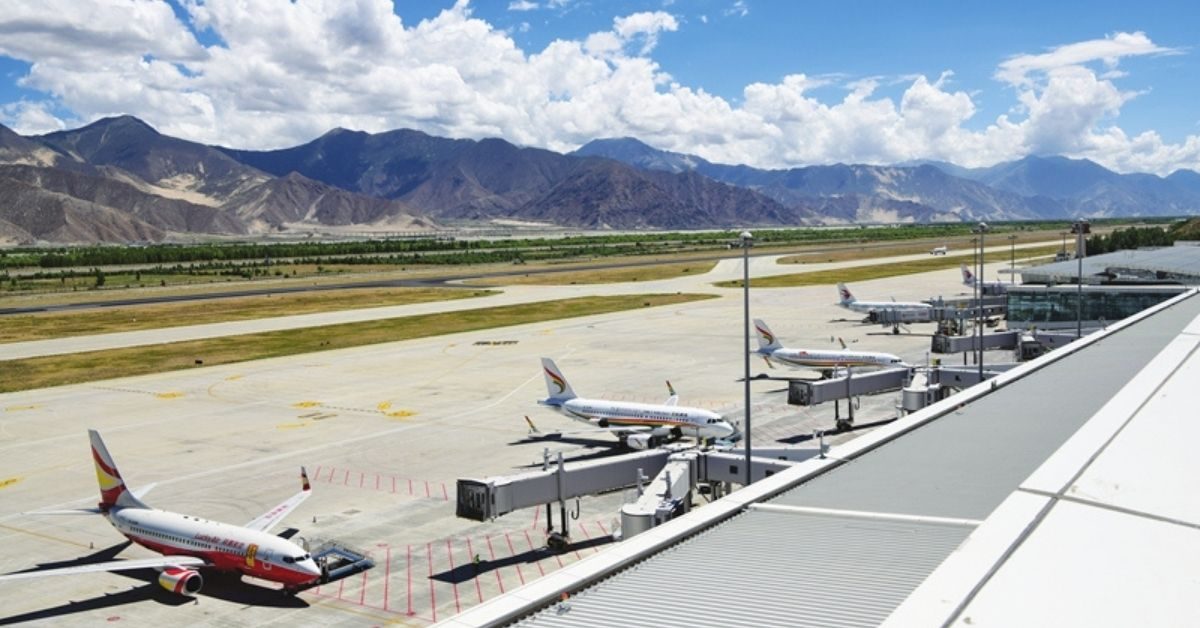From airports to high-speed rail, China has been beefing up efforts to build up a complete transport system in the Tibet Autonomous Region, an area situated on the Qinghai-Tibet Plateau where transportation has long been a bottleneck inhibiting its development.
The move, backed by years of effort and huge investment, is of great significance not only for the economic development and people of Tibet, but will also have a far-reaching impact on the neighboring region and other China-proposed Belt and Road countries including Nepal, observers said.
In the latest progress, the T3 terminal of Gonggar Airport in Lhasa has passed the final acceptance test on June 30, indicating that main construction of the airport has been completed.
As the largest airport in the region, it is estimated that Gonggar Airport will see an annual throughput of 9 million passenger trips by 2025, said a report from the Xinhua News Agency.
China has in total approved the construction of the three new airports and the expansion of the Lhasa Gonggar Airport in Tibet, with the airports being respectively located in Lhunze County, Tingri County and Burang County.
In another mark of progress on June 25, the Lhasa-Nyingchi railway also started operation, marking China’s most advanced Fuxing bullet train to run on the Qinghai-Tibet plateau for the first time.
With a length of 435 kilometers and a designed speed of 160 kilometers per hour, the new railway is a single-line electrified railway, passes through 47 tunnels and across 121 bridges and crosses the Yarlung Zangbo River 16 times. Tunnels and bridges account for about 75 percent of the total length of the railway.
The railway’s annual freight transport capacity of 10 million tons also provides strong support for the flow of goods, according to Xinhua.
Benefits beyond border
Built in an extreme environment with a complicated road construction situation, the efforts will in no doubt promote economic development and improve people’s lives in Tibet, experts noted, while adding that the impact will be further expanded to other neighboring countries and regions with a better connectivity under the infrastructure plan.
Since late 2012, China has been increasing its infrastructure investment in Tibet. Tibet has launched a total of 130 new air routes, with 61 cities connected by plane. The number of passenger trips made through these airports totaled 5.18 million in 2020, official data showed.
This large scale investment in transport across the region has not only been welcomed by the Chinese people but also those in South Asia who are also looking forward to the economic boost that the opening of the Lhasa-Nyingchi Railway can offer as another extension that shortens the distance between cities in other provinces in China and Nepal, Qian Feng, director of the research department at the National Strategy Institute at Tsinghua University, told the Global Times on Monday.
For example, China and Nepal have already planned a trans-Himalayan new era connectivity network running through China’s Tibet and other countries such as Nepal, Qian said.
The trans-Himalayan multi-dimensional connectivity network is currently a key strategic link between the two countries and is gradually taking shape. The two countries are working toward expanding border ports, railway, road, aviation and telecommunications networks.
Analysts forecast that the network will bring about hitherto unparalleled transformation of the region between China, South-West Asia, Nepal, South Asia and also Central Asia.
The construction of the network will contribute to economic development and the realization of Sustainable Development Goals by enhancing productivity, transfer of technology and employment creation. The development of connectivity infrastructures will facilitate Nepal’s third country trade via China, as envisaged by Nepal-China Transit Transport Agreement, Sushil Kumar Lamsal, Minister and Deputy Chief of Mission of the Embassy of Nepal in China, told the Global Times on Monday.
The Nepali official also expressed hope for more connected tourism and trade between China and Nepal through the network. “There is huge untapped potential in further advancing co-operation in the tourism sector between our two countries due to geographical proximity, socio-cultural similarities and age-old friendship between them.”
The number of Chinese tourists visiting Nepal has been increasing consistently over the years. China is the second largest source country of tourists visiting Nepal. In 2019, the number of Chinese tourists in Nepal was 169,543, an increase of 14.2 percent over the previous year.
As close partners under the Belt and Road Initiative, Nepal and China should accelerate mutual co-operation in reaping the low-hanging fruits that sectors such as tourism have in plenty to offer, apart from trade, investment and connectivity, Lamsal said.
While China is escalating the infrastructure development for the benefits of the people in the whole region, India is also building new border infrastructure meanwhile, while experts cautioned that the move might only aims to narrow gap with China rather than for the real benefits of its own people.
India is still quite behind China in terms of border infrastructure, but “all-out efforts are being made to narrow the gap,” said a report from the Times of India in June, citing government officials.
Toward enhancing border connectivity, India has e-inaugurated 12 roads built by Border Roads Organization (BRO) in mid-June, which includes a 20-km Kimin-Potin double lane one among others, according to the report.
“Unlike the Chinese investment, India is more focused on military use to try to confront China,” said Qian.
Source : Global Times







